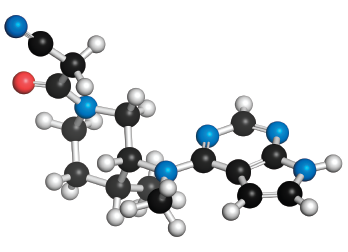
Tofacitinib, a rheumatoid arthritis drug.
MOLEKUUL / science source
CHICAGO—Amid what she called a “dizzying array of choices” for rheumatoid arthritis (RA)—from anti-TNF and anti-IL6-receptor therapies to B cell depletion to new biosimilar options—disease treatment should still revolve around several basic concepts, an expert said at the ACR State-of-the-Art Clinical Symposium in April.
Joan Bathon, MD, chief of rheumatology at Columbia University in New York City, laid out four main principles clinicians should use to guide their choices as new therapies march onto the RA landscape.
First, she said, early treatment should be the primary aim, to prevent damage and disability. “We want to start DMARD [disease-modifying anti-rheumatic drug] treatment as soon as you make the diagnosis—hopefully that’s within six weeks of either recognition of the symptoms or a definitive diagnosis,” she said.
Second, she said, “Treat hard.” In other words, treat patients with the maximum effective dose they can tolerate, with a rapid escalation of DMARDs.
Third, patients should generally be treated with a combination of DMARDs, when appropriate, because combination therapy is consistently more effective than monotherapy. “One thing’s for sure,” Dr. Bathon said. “If your patient has bad prognostic signs … you want to think about combination therapy.” Those signs could include a very high number of swollen joints; exceptionally high erythrocyte sedimentation rates, C-reactive protein levels, rheumatoid factor or cyclic citrullinated peptides; or erosions at baseline.
Finally, treatment should have a goal in mind—ideally remission, but at least low disease activity, Dr. Bathon said.
Lessons Learned
Lessons from the 2007 BeST study on early RA remain highly relevant, she said.1 The study evaluated several approaches, including a series of monotherapies, a step-up approach to combination therapy, a combination as initial therapy or a methotrexate-infliximab start. In each arm, remission was the goal, and treatment had to change every three months if a Disease Activity Score 44 (DAS44) of 2.4 or lower wasn’t achieved.
Improvements in signs and symptoms were seen regardless of the therapy and strategy, although radiologic outcomes were better with early combination therapy than delayed combination therapy.
These results hold a crucial lesson, Dr. Bathon said. “Goal-directed therapy is really optimal,” she said.
A sensible treatment algorithm, she said, is to start with methotrexate monotherapy unless it’s contraindicated, and then add a second DMARD if the response isn’t good enough. If you see residual disease activity, she said, add a nonbiologic or a biologic therapy depending on the severity.

